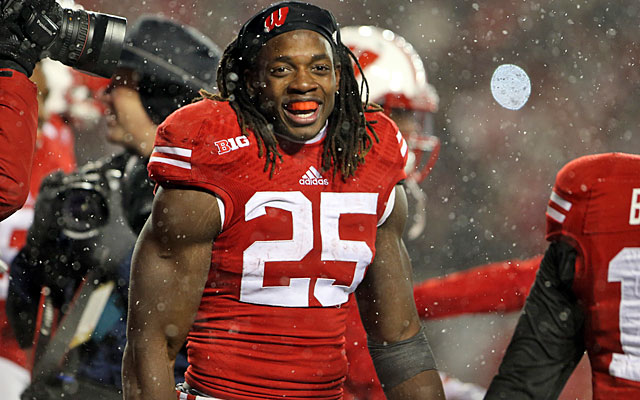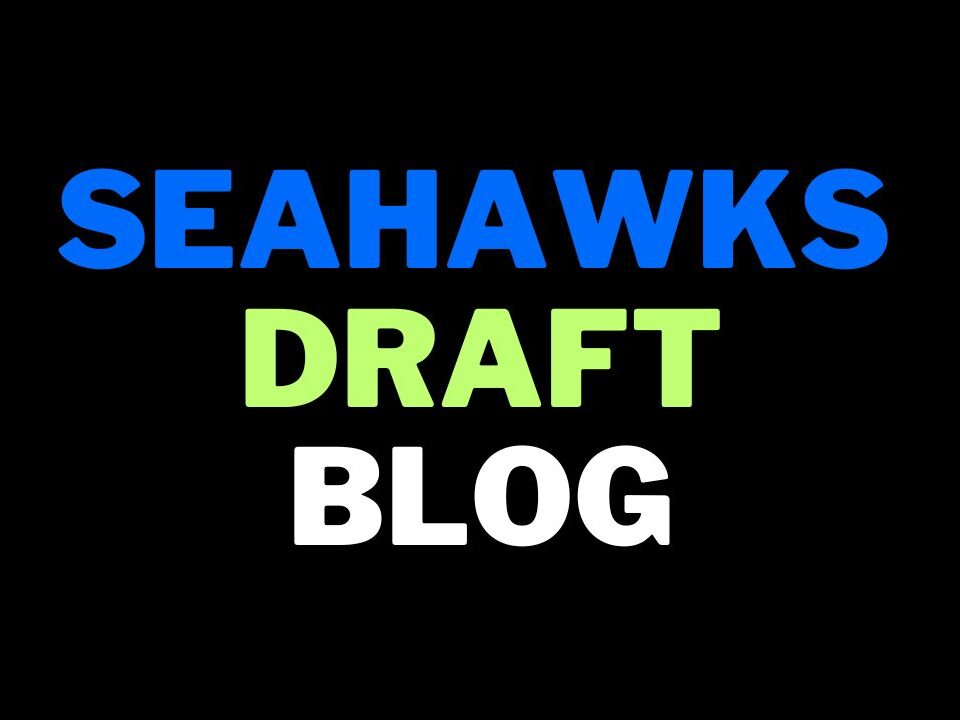
Gym-rat Melvin Gordon will almost certainly interest the Seahawks
What I considered making this list:
1. It’s about more than SPARQ
The Seahawks love difference-making athleticism, but it’s not the be-all and end-all. Bruce Irvin is a stunning athlete but he was also the best pass rusher in college football in 2010 (he had a good season in 2011 too). Bobby Wagner was productive and so was Russell Wilson. Earl Thomas had eight interceptions in 2009 for Texas. More recently, Paul Richardson had a 1343-yard season for Colorado — including ten touchdowns. Yes — they want the best athletes. But there needs to be a level of production to back up the potential.
2. They need to fit in
Before the last draft Pete Carroll and John Schneider talked about finding players that can survive in Seattle’s ultra-competitive locker room. A potential defensive prospect has to mesh with the big personalities on this team. A receiver has to be comfortable competing against the LOB every day. Character, self-confidence and competitiveness has to be part of the make-up here. Shy and retiring won’t cut it.
Running backs
Whether it’s retirement or just time to move on, Marshawn Lynch’s days in Seattle (sadly) appear numbered. This will leave a big hole in the running game. Unlike a lot of other teams that treat the position as an afterthought, the Seahawks want to dominate in the run game. They’ve had a superstar playing the position during Pete Carroll’s first five seasons in Seattle — they’d probably like another X-Factor player to lead the rushing attack going forward. It’s a good class for running backs with three stand-outs.
Melvin Gordon (RB, Wisconsin)
There’s every chance he’s a top-15 pick and therefore out of reach for the Seahawks. If he lasts, it could be a no-brainer. He’s a totally different player to Lynch but ticks all the required boxes: he’s a fantastic athlete and gym rat, he has major production (Heisman finalist) and a competitive, team-friendly personality. You can imagine him shadowing Russell Wilson, working identical hours. A lot of teams will grade Gordon in the top 15-20 but need and positional value could keep him on the board. It’s a long-shot to think he’d be there for the Seahawks but he’s also the type of player you can build around. You can imagine John Schneider really liking him. Enough to move up? Maybe.
Production: 2336 rushing yards in 2014, 29 total touchdowns
Todd Gurley (RB, Georgia)
In terms of pure talent Gurley would be among the top five players in the draft. He won’t go that early because of a nasty ACL injury towards the end of the college season. He probably won’t work out pre-draft and the fierce nature of the position plus an injury history might put some teams off. One of two things will happen in April: a team in the teens will take a punt on his obvious potential or a really good team in the 20’s or 30’s is going to get a rehab project for the ages. If the Seahawks were willing to play the long-game with Gurley they could end up with another superstar to replace Lynch. He’s a 230lbs home-run hitter who returns kick-offs for TD’s, explodes through running lanes, knows how to break a tackle and work into the passing game. You might not get an immediate return due to the injury, but when he’s healthy — Gurley’s a beast. He commands respect from his team mates. Business like personality, speaks with ingrained self-belief.
Production: 911 rushing yards in just six games, 10 total touchdowns
Tevin Coleman (RB, Indiana)
Coleman deserves as much attention as the other two, especially after a fanastic season for the Hoosiers. Everything you read about him is positive — he’s loved by the Indiana coaches. He had a close family upbringing and stayed in contact with his Pee-Wee coaches. He was born three months premature and given a 20% chance of living. He’s a humble, respectable individual. On the field he’s electric — a terrific one cut and go runner. He has the size to work up the middle but he’s at his best finding a crease and exploding. Intense competitor on the field and throws his body around in pass protection. Always seems to fall forward. He should go in the top-40 and whoever gets him will land a productive runner for the next few years. It’ll be interesting to see how he does at the combine but he looks athletic and he ticks all the boxes in terms of competitiveness and character.
Production: 2036 rushing yards in 2014, 15 total touchdowns
Wide receivers
Even after drafting Paul Richardson and Kevin Norwood in 2014, the Seahawks stand to add another option to their passing game in the off-season. They’ve lost Percy Harvin and Sidney Rice in the last few months. They have a lot of similar receivers in terms of size, frame and speed. They don’t have a player with Harvin’s explosive ability or Rice’s size. For that reason there’s every chance they’ll consider another early pick here. Ideally they’d grab a big target — but the options are limited. Michigan’s Devin Funchess looks the part but he’s not a self motivator and needs to be pushed. He’s also inconsistent catching the ball and never lived up to expectations.
Kevin White (WR, West Virginia)
He ticks all the boxes with his on-field play. White high points the football naturally with terrific catching technique. He’s a physical receiver who competes for the ball in the air. He’s shown he can be a red zone threat and a reliable third-down target. He’s not a burner but he can run away from speedy cornerbacks on shorter routes exploiting YAC. His team mates really respect him at WVU and have taken on his “Easy” catchphrase after making a big play. Turned his career around after a tough start in the JUCO’s. Has a little Larry Fitzgerald to his game even if he doesn’t look as imposing physically. Could easily go in the top-20 but he’s also a one-year wonder and there’s some depth at receiver again this year.
Production: 1318 receiving yards in 2014, nine touchdowns
Sammie Coates (WR, Auburn)
A candidate to be the best athlete at the combine, Coates is just a rare combination of muscle and speed. He made #1 in Bruce Feldman’s annual ‘freaks’ list for 2015. He’s also a humble individual who befriended a young cancer sufferer and spends a considerable amount of his free time with her. On the field he’s inconsistent — he drops too many passes and doesn’t have major production in a run-heavy scheme. I suspect Seattle is willing to look beyond production if you make the most of your limited chances — that’s why they drafted Kevin Norwood. Coates isn’t anywhere near as efficient as Norwood but he did make some key plays in big games against Alabama and LSU. Essentially he’s a big-time threat downfield and has the size to play the Sidney Rice role. Major SPARQ candidate.
Production: 23.90 YPC, three of his four big-play touchdowns occurred when Auburn trailed
D’haquille ‘Duke’ Williams (WR, Auburn)
Coates’ team mate at Auburn is a very different player — perhaps the type Seattle has lacked. He just looks like a #1 receiver with similar size to Dez Bryant. Big hands, long arms, great size. Williams has only played one season with the Tigers and already looks like a stud. He’s just a very naturally gifted player who will, one day, be a very effective NFL receiver. He was the unquestioned leader at his old JUCO team and he plays with an edge. He wouldn’t have any trouble surviving Seattle’s fierce locker room. He’d provide a red zone threat and another option over the middle/working the seam. He might need some seasoning — it’s tough to go from the JUCO’s to the NFL after just one year in the SEC. But he’s such a natural pass-catcher you wouldn’t bet against an early impact. The sky’s the limit for Williams.
Production: 730 yards and five touchdowns in ten games on a run-heavy offense
Pass rushers
After extending Cliff Avril’s contract they might steer clear of a high pick at defensive end. Depth is the key really and there’s enough talent to wait until the middle rounds. They could even bring in a Brian Orakpo or Jabaal Sheard in free agency, depending on how much cap room is left. Even so — this is a terrific class for pass rushers. Not all fit Seattle’s penchant for length, explosive speed (eg 1.50 ten yard split) and production. The ones that do could be on the radar.
Eli Harold (DE, Virginia)
He’s a project with major upside. When you watch Harold on tape there’s a lot to work on. He has a ton of snaps where he struggles to have an impact. But then he’ll fly around the edge at warp-speed to make a splash play. His get off is potentially elite. He looks like he’ll run an outstanding ten yard split and he appears to have enough length to interest Seattle. Hand placement can be improved and you wonder if he’ll be able to win using just speed but the upside is clear to see. What I like most about Harold, aside from the athleticism, is his personality. He’s incredibly mature. Lost his mother at a young age and made Virginia coach Mike London a father-figure. Speaks with tremendous passion and heart. You want to root for him.
Production: 14.5 TFL’s in 2014 plus seven sacks
Shawn Oakman (DE, Baylor)
What isn’t Seahawky about a 6-8, 285lbs defensive linemen who is the heart and soul of his team and plays loose and ferocious at the same time? Oakman has battled adversity, poverty and disappointment to become the leader of the Baylor Bears. His back-story is fascinating and his athletic potential is outstanding. If he declares he too could be one of the stars of the combine. He carries minimal body fat — he’s 6-8 and pure muscle. He plays with great upper body strength. He’s not the most agile as you’d expect but his straight-line speed is fine. He’s different in a good way. He could be special. The Seahawks like ‘special’ difference makers. There aren’t many human beings like this. He does struggle to get off blocks but you see his power and length every snap. He could develop into a more athletic Calais Campbell.
Production: 18.5 TFL’s in 2014 plus 10 sacks
Bud Dupree (DE, Kentucky)
I think Dupree could be a top-15 pick but others have him in the late first. He doesn’t have great length and that could be an issue. Everything else about his game is so ‘Seattle’. He’s a big time leader, a disruptive pass rusher with tremendous athleticism. He could play defensive end and outside linebacker. He flies to the ball and constantly makes plays. You have to account for his presence every snap. Technically he’s assured and he’s primed to make a quick impact at the next level. It’s impossible not to admire Dupree and he’ll have a long and successful NFL career wherever he ends up. His coaches love him and he’s dragged a struggling program towards relevance in the SEC this season. Very mature and accomplished.
Production: One pick-six, 12.5 TFL’s, 7.5 sacks, two forced fumbles, five QB hurries and a blocked kick in 2014
Other positions
I’ve listed three possible needs above but there’s every chance they just take one of the better players on their board. This is a good enough team to not have to go after specific needs, especially when you have 10-11 picks and a track record of finding starters in the later rounds.
Shaq Thompson (LB, Washington)
Incredible range. It’d be fun to consider how the Seahawks would use him in their defense. He could do some rushing off the edge, he could line up in any of the linebacker spots. They could use him as a roaming safety similar to Deone Bucannon. Could they use him to cover a specific target? He could even take some snaps at running back and be a special teams demon. He’s a playmaker and a great athlete — the type creative coaches (like Pete Carroll) love to get their hands on. In many ways it’d be interesting to see Thompson game-planned into different roles instead of being used as an orthodox outsider linebacker.
Production: 456 rushing yards (two TD’s), three fumble returns for touchdowns, a pick-six, two TFL’s and a sack
T.J. Clemmings (T, Pittsburgh)
A converted defensive linemen with plenty of upside. He admits he had a rough first year after the switch but settled into the right tackle spot in 2014. Honest, talented and room to develop. A lack of experience will concern some in a relatively good tackle class — especially considering he didn’t cover the blind side. I’m not convinced Seattle will spend yet another high pick on the offensive line but with Russell Okung’s contract nearing it’s conclusion and Justin Britt struggling a bit they could consider it. I think an extension for Okung and patience with Britt is more likely, but we’ll see. After Stanford’s Andrus Peat, Clemmings is the most intriguing tackle in the class for me.
Production: Pitt ranked 16th nationally for rushing yards, with Clemmings leading the way
Eddie Goldman (DT, Florida State) & Malcom Brown (DT, Texas)
I think the Seahawks are happy to use the second-wave free agent market and middle rounds to go after interior defensive linemen. I think it’d take a really special talent (such as Aaron Donald) to force their hand. I’m not convinced we’ll see them take a first round defensive tackle in 2015. The two players that might fit are former 5-star recruits Goldman and Brown. Goldman in particular is a tremendous athlete with genuine power in the running game. He could rise into the top-ten with a good off-season. Brown is no less impressive and also excels against both the run and pass. I’d expect both to be off the board before Seattle’s pick.
Production: Goldman — eight TFL’s and four sacks, Brown — 12.5 TFL’s and 6.5 sacks



